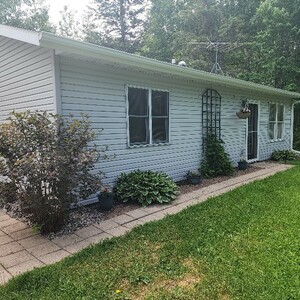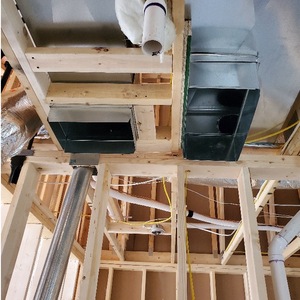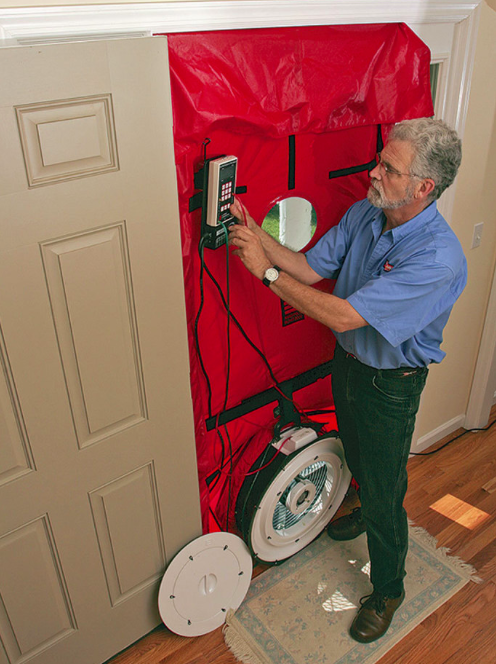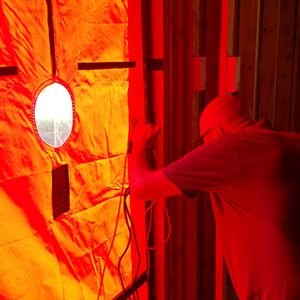
I recently attended a BS* and Beer meeting in Kansas City, MO. It took place in a house being built by Jake Bruton’s company, Aarow Building. It is a single-level, slab-on-grade structure, measuring roughly 3250 sq. ft. When I was there, they were just finishing the mechanical, electrical, and plumbing systems and about to move to the insulation phase—an ideal time for a mid-build blower door test.
The purpose of a mid-build blower door test is to confirm the building is on track to meet the desired airtightness metric. In this case, it’s 1 ACH50 or less, which all of Jake’s new homes are contractually bound to achieve. A mid-build test also identifies any missed opportunities for air-sealing.
The simplest blower door test puts the house under negative or positive 50 Pascals (Pa) of pressure and records the cubic feet per minute (CFM) rate of air exchange; this is called a single-point blower door test because it puts the house at just one pressure. If the calculated air changes per hour at 50 Pa (ACH50) number is too high, set the fan on “cruise control” and go find the air leak locations. There’s no need to perform multi-point testing—where CFM rates are measured at progressively lower pressure points, usually starting at 60 Pa—this early in the build. That type of test is most effective and informative when performed toward the end.
This home measured 35,600 cu. ft. and had 9250 sq. ft. of surface area including the floor, walls, and ceiling. The home tested at an impressive 180 cu. ft. per minute of airflow through the fan at the test pressure of -50 Pa (180 CFM50). From this number, we can calculate the air changes per hour and CFM per sq. ft. of surface area metrics:
ACH50 = CFM50 x 60 min.…
Weekly Newsletter
Get building science and energy efficiency advice, plus special offers, in your inbox.

This article is only available to GBA Prime Members
Sign up for a free trial and get instant access to this article as well as GBA’s complete library of premium articles and construction details.
Start Free TrialAlready a member? Log in















12 Comments
Randy,
Fabulous information on how air infiltration is measured. Good to hear Gary Nelson's goal of 1 ACH50 as a target. This is achievable for most residential projects and will set the stage for real building performance. Natural air change is the calculation used for heat loss analysis, is it really a straight calculation in your opinion? Do tight homes perform better than specified and drafty homes more poorly with regard to air infiltration heat loss. I am somewhat out of the loop these days on the latest energy modeling, please enlighten.
Happy New Year !!
Doug
Thanks Doug!
As far as modeled performance, I have a project going in Northern Minnesota where we just tested at an air leakage rate of 140 cfm50, .39 ACH50. I revisited the REM/Design model I built for the project and entered those air infiltration numbers. The heating system size needed is 39,600 BTU at the design temperature of -23°F. Estimated heating costs in the model were $2831 for the heating season. Changing the infiltration rate to 800 cfm50, which is around 2.25 ACH50 increases the heating cost by $400 per heating season. An increase of about 12%. The heating system design size would need to be increased to 44,000 BTU. I'll have the opportunity to monitor this home over time, we'll see how it performs compared to the model.
On a side note, when I chatted with Gary about his opinion of 1 ACH50, he also brought up that he can now tell (after renovating his home) when his ERV isn't operating correctly. His indoor air quality and humidity changes enough that he finds himself checking on what's going on. Before the renovation, with his air leakage rate around 3 ACH50, there were enough natural air leaks so that he didn't know if the system was operating correctly.
Happy New Year to you as well!
Randy
More to my first post. Much has been discussed on GBA as to the accuracy of blower testing to predict real building performance. We do dramatic whole house depressurization to arrive at an ACH50 or CFM 50 leakage rate. This will determine airtightness but the blower door does not replicate the typical air leakage pathway in heated buildings. With the very airtight and energy efficient buildings, Passive House and the like, I wonder if energy modeling has kept up. We blower door test to determine airtightness, and then convert this to ACH Nat to do the heat loss calculation. I suspect the very energy efficient buildings are losing less heat to infiltration than the heat loss analysis would indicate. And conversely, older. less efficient buildings could be losing more heat to infiltration. Those of us living in a cold climate know that on the very coldest days in an older home the furnace runs just about full time. Some crazy cold climate heating dynamic in these older homes that would not be present in an airtight and highly efficient home.
The 26 in that equation is from multiplying 24 hours in a day (converting degree days to degree hours) by 60 minutes per hour (converting cubic feet per minute to cubic feet per hour) by .018 (the specific heat of air per cubic foot is .018 Btu/ft3/F).
The cooling equation .026 seems wrong- it should be the same as heating value but divided by 3412 Btu per kWh.
Edit -- it's actually correct due to SEER being 3.412 * efficiency (see below)
Thanks for clarifying the constant.
As far as the cost of the air leaks for cooling, the formula is from the Energy Conservatory's Tectite software I use for blower door testing. Attached is the screen shot from the help menu. If it's not accurate, I'm sure they would want to know.
FYI, its rare I see the cost of air leaks for cooling in my climate over a few dollars, often $1-3 dollars, just because our CCD are around 250. Now heating on the other hand, with around 9500 HHD, I've seen those costs estimated at over $1000 for poorly air sealed homes.
Note that the link ( https://www.northernbuilt.pro/energy-audit-calculating-the-cost-of-a-homes-air-leaks/ ) uses CDD base 78, but this Energy Conservatory reference uses base 70 which will result in very different savings.
I see now that the .026 is actually correct because the cost per kWH needing to be divided by 3412 is further adjusted by the fact that SEER is efficiency times 3.412, resulting to .026 (26 * 3.412 / 3412)
Also, the equation should use CDD65 or maybe as high as CDD70, but CDD78 is far too high a reference temperature and dramatically understates cooling loads unless people set their AC to 88! The heating reference temperature is also too high, especially for new construction in cold climates. It should use HDD60 or even less. So, as written, the calculation can be expected to significantly overstate heating impacts and understate cooling impacts. Heating and cooling reference temperatures should average around 10F lower than the thermostat setpoints, closer to 15F lower for well insulated homes.
Just to spread some useful information on comparing ELA and EqLA--Energy Conservatory has noted that EqLA is closer to the "size of the hole" that you actually observe. I.e., you add a 1 square foot hole by cracking open a window, and EqLA goes up ~1 square foot.
https://energyconservatory.com/support/how-do-i-calculate-the-leakage-area/
"Importantly, when using leakage area calculations to demonstrate physical changes in building airtightness, we recommend using the Canadian EqLA measurement. Typically, EqLA more closely approximates physical changes in building airtightness. For example, if you performed a blower door test, and then opened a window to create a 25 square inch hole and repeated the test, the estimated EqLA for the building will have increased by approximately 25 square inches from the initial test result. The EqLA is also easier to measure, especially in windy weather, because the measurement is taken at a higher building pressure than the ELA."
Thanks Kohta!
Great article and comments! The cfm results you report are unheard of here in the Pacific NW, unless someone is building to PH levels or it's a tiny home! We live in a moderate climate (marine 4) with very different HDD and CDD - our savings at first glance, look to be considerably less than these examples. Thanks for the food for thought!
"the entire volume of air inside the house is exchanged with outside air every .303 hours.
Another way to say this is: All the air inside the building is exchanged with outside air once about every three hours. "
Come again?
.303 air changes per hour at 50 pascals x 3 hours = .909 or just under 1 complete exchange of the home's volume of air. It would actually be closer to 3 hours and 20 minutes for 1 complete air change. This is under the artificial test pressure while the blower door is operating. The natural air change rate is much slower, estimated at 2.3 days.
Log in or become a member to post a comment.
Sign up Log in